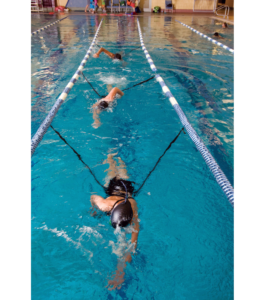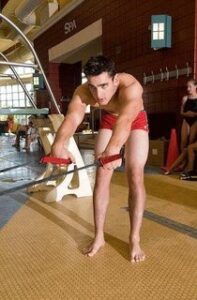“How do I train for a triathlon while traveling?” is one of the most common questions I get. Traveling can be fun and exciting. But it can also kill a triathlete’s training program…or at least severely hamper it. Finding a time and place to squeeze in a swim workout can be a challenge. Whether for business or pleasure, travelers are often at the mercy of other people’s schedules. And, while it’s not hard to find a hotel with a treadmill and stationary bike, most hotel swimming pools are nowhere near long enough for a proper swim workout.
But some careful planning and a couple of swim devices can help. Here are a few tips for training for a triathlon while traveling:
Scope Out a Local Pool
While the hotel pool might not be long enough for a training session, there’s a good chance that a local pool is. Visit SwimmersGuide.com and search for pools in the area you’ll be visiting. The site gives you a list of pools close by. It also gives you the size of pool, opening hours, pricing, contact details and more. If you find a pool close by, it’s a good idea to call ahead and ask about the best times to swim. Often, other swim programs take up some of the lanes, squeezing lap swimmers into a couple of lanes. You might also ask whether a masters swim program or triathlon club meets at the pool. It’s always good to train with a group.
Travel with a Stationary Swim Trainer
A short hotel pool is often the most convenient option. If that’s the case, consider traveling with a stationary swim trainer. This is one of my favorite swim training aides. In fact, I often use it even when I’m in a 25 yard pool because it helps me simulate an open water swim.
 A stationary swim trainer is a belt with one or two bungee cords attached. The belt goes around your waist, while the other end of the bungee anchors to something. Trainers with a single bungee chord anchors to something on the pool deck. A trainer with double bungee chord anchors to a lane line on either side of the swimmer. Some swim trainers use foot straps to hold the swimmer in place rather than a belt around the waist. Personally, I prefer the waist. While a belt around the waist restricts my body roll a little, I prefer to keep use of my feet.
A stationary swim trainer is a belt with one or two bungee cords attached. The belt goes around your waist, while the other end of the bungee anchors to something. Trainers with a single bungee chord anchors to something on the pool deck. A trainer with double bungee chord anchors to a lane line on either side of the swimmer. Some swim trainers use foot straps to hold the swimmer in place rather than a belt around the waist. Personally, I prefer the waist. While a belt around the waist restricts my body roll a little, I prefer to keep use of my feet.
A stationary swim trainer turns a short pool into an endless pool. I like to use my swim trainer with a freestyle snorkel and waterproof MP3 player. Using the snorkel means I don’t have to worry about turning my head to breathe allowing me to focus on maintaining a balanced stroke. The MP3 player stops me from getting bored. I recommend this set up.
My favorite stationary swim trainers are the StrechCordz Stationary Swim Trainer and the StrechCordz Long Belt w/Slider.
Get a Swim Workout in Your Room
Sometimes the client you traveled to meet is only available during your scheduled swim time. Or, when visiting family, your nephew’s football game kicks off right when you planned on diving in. All is not lost. Another device, also made using bungee chords, gives you a quick way to keep your freestyle muscles tuned.
 Stretch cords are resistance bands for swimmers. Many competitive swimmers use them. They are, again, made from bungee chords, with a handle on one end and an anchor on the other. Swimmers simulate the underwater pull, helping strengthen their back, arms and shoulders. It’s important to keep the elbow high at the beginning of each pull and extend the arm at the end.
Stretch cords are resistance bands for swimmers. Many competitive swimmers use them. They are, again, made from bungee chords, with a handle on one end and an anchor on the other. Swimmers simulate the underwater pull, helping strengthen their back, arms and shoulders. It’s important to keep the elbow high at the beginning of each pull and extend the arm at the end.
There are a variety of bungee thicknesses available, offering differing levels of resistance.
Stretch chords are easy to travel with and, in a pinch, allow travelers a chance to exercise the same muscles used in freestyle.
I recommend that all triathletes incorporate some stretch chord exercises into their training. It’s a quick, convenient way to work key freestyle muscles.
My favorite bands are the StrechCords Modular Resistance Bands.
Swim training for a triathlon while traveling can be challenging, but not impossible. I encourage you to find a close-by pool. If that fails, use the hotel pool, using a stationary trainer. And, as a last resort, do some extra dryland exercises, using stretch cords. Good luck and safe travels.
